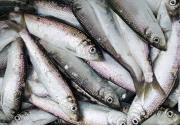For small fish, Pacific herring are a big deal.
A culturally significant fishery in California, herring have a long history as a commercial staple. Pacific herring are also an important link in the food web — connecting microscopic zooplankton with larger marine predators in the North Pacific like Chinook salmon, California sea lions and brown pelicans.
Despite their significance, uncertainty remains regarding the factors that influence herring population dynamics in the estuary environment.
According to the California Pacific Herring Fishery Management Plan, the population of adult fish has hit notable lows in recent years — the 2018-19 season saw the second lowest number of adult Pacific herring on record at an estimated 8,030 tons. This was also the fifth year in a row of below average herring numbers, causing researchers to look more closely at the impacts of climate change as a potential cause.
A team of researchers at the University of California, Berkeley set out to understand how environmental changes in the San Francisco Estuary may influence herring population dynamics. The UC Berkeley team included former graduate student Nina Pak, post-doctoral researcher Denise Colombano, professor Stephanie Carlson and assistant professor Albert Ruhi, who received a California Sea Grant 2021 New Faculty Award to investigate this issue.
In the first year of their lives, Pacific herring live in the estuary, feeding on zooplankton. Then they migrate out to coastal waters for the majority of their mature lives, returning in the late autumn and winter to spawn in the estuary. This is why studying the estuarine environment is so critical to understanding Pacific herring population dynamics — it provides crucial habitat for spawning and for juvenile fish. In California, the San Francisco Estuary provides the bulk of this habitat for juvenile herring. Composed of North Bay, Central Bay, South Bay and Suisun Bay, conditions differ across the estuary. This variation is good for the integrity of the species because it offers multiple opportunities for foraging and growth in different places at different times.
“It’s actually very important for population stability,” Ruhi said. “It’s the idea that we shouldn’t put all of our eggs in the same basket. These fluctuations across regimes cancel each other out, and you have a very stable portfolio.”

But this variation also makes it difficult to identify the specific factors that influence Pacific herring population dynamics. Pacific herring populations are known to fluctuate dramatically, often following a “boom and bust” pattern. For this study, the researchers looked at more than three decades of long-term spatially-structured data provided by the California Department of Fish and Wildlife (CDFW), specifically fish biologists Thomas Greiner and James Hobbs.
The researchers focused on juvenile Pacific herring during their estuarine resident stage. They examined several potential drivers of abundance fluctuations: the effects of temperature and salinity; the effects of adult spawning biomass; and the effects of density dependence, which could reflect a limited carrying capacity in the estuary due to competition for resources.
When looking at temperature and salinity, researchers found a mixed bag. Juvenile Pacific herring were able to thrive in cool and salty conditions, and even during drought, when saltwater extended further inland. But warmer water temperatures during marine heatwaves likely negatively impacts populations, signaling the potential for major climate change impacts on juveniles, as these heatwaves are increasing in frequency, duration and severity. In addition, the researchers found strong evidence of density dependence — indicating that juvenile herring experience competition for resources (things like food and cover) in the estuary, which could limit their population growth.
Pak and her team suggest that a key way to protect Pacific herring from climate-induced changes is by restoring and protecting eelgrass and tidal marsh habitat throughout the estuary.
“Because eelgrass and tidal marshes provide critical nursery habitat for juvenile fish, restoring these habitats will increase the number of herring the estuary supports,” Pak said, adding that their findings suggest that fisheries managers need to consider impacts of climate change on juvenile populations when making recommendations, and not only focus on adult populations.
To help ensure a robust Pacific herring fishery into the future, Ruhi, Pak and their team recommend that ongoing ecosystem-based fishery management focus on habitat restoration and food web recovery which could increase the number of herring the estuary can support, and restricting harvest during challenging environmental conditions.
This research was published open-access in the journal Ecosphere in May of 2023. Pak hopes that what people take away from it is that extensive data sets over time can unlock the answers to a number of questions about the future.
“With long term data we can answer questions about which environmental conditions and biological drivers could ultimately shape the population dynamics for a species like Pacific herring,” Pak said.
Ruhi agrees.
“The fact that now we can go back and see what herring were doing back in the 1980s, and capture El Niño years and multi-year droughts, has enormous value,” Ruhi said. “And every time we add an extra month, an extra year and so on, the value increases.”
About California Sea Grant
NOAA’s California Sea Grant College Program funds marine research, education and outreach throughout California. Headquartered at Scripps Institution of Oceanography at the University of California San Diego, California Sea Grant is one of 34 Sea Grant programs in the National Oceanic and Atmospheric Administration (NOAA), U.S. Department of Commerce.